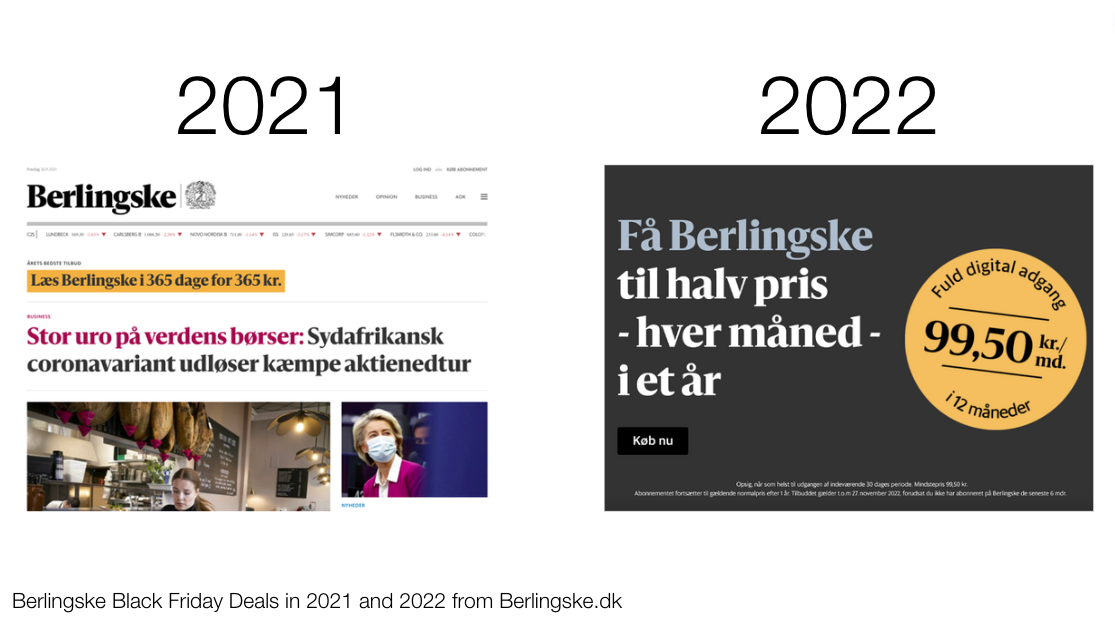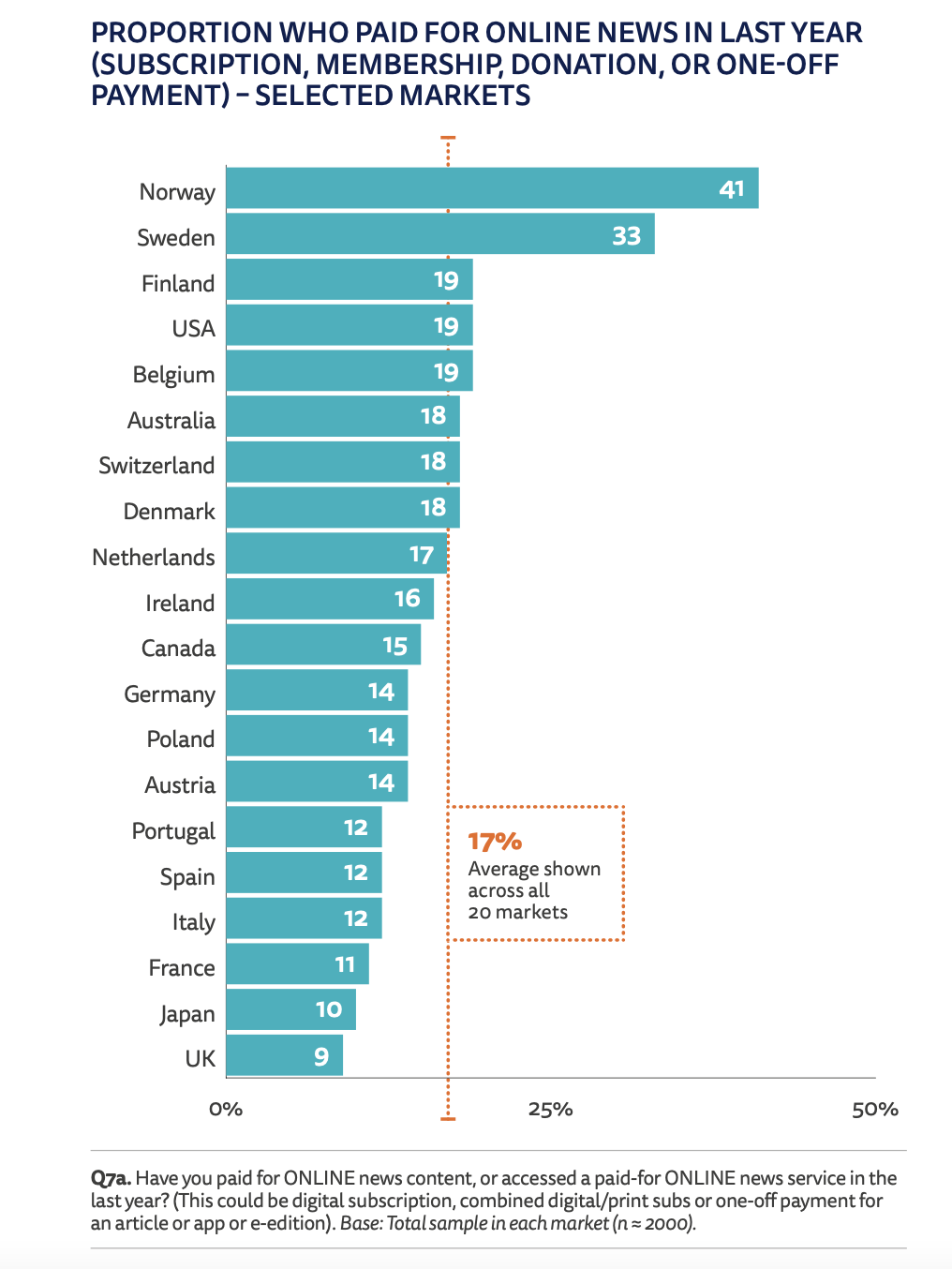Long-term subscriptions and low price points: how publishers approached Black Friday 2022
Black Friday has grown beyond American shores and people across the world are on the lookout for their chance to grab a bargain. To leverage this hype, publishers have leaped onboard with offers in all different shapes and sizes. To look further, we studied the websites of 60 publishers from 17 different countries this Black Friday to see their attempt (or lack of) to get new subscribers on board. Of the 60, 37 offered specific Black Friday Deals and we discuss the findings below.
An average price of €0.01 – €2.99 a month, but fluctuating discounts
With different publishers offering different price points, lengths and currencies, we standardised all prices to reflect a monthly price in Euros. Choosing the correct digital pricing is hard enough for publishers, but special offers throw another spanner in the works.
Appealing to the bargain hunters, 18 publishers priced their subscriptions between €0.01-€2.99 a month, a low-cost entry point into a paying relationship. At this price, readers spend around the same as they would for a single print edition and but they get more bang for their buck.

Just 2 publishers used Black Friday to offer free access to their premium content. Svenska Dagbladet offered 3 months of access to new users, whilst Die Zeit in Germany offered their users 1 month. This is an interesting move as it gives subscribers a chance to “try before you buy” and lets publishers obtain registration data whilst building a relationship. 4 publishers charged between €11-€14.99 for their content. Italy’s Il Sole 24 Ore and Denmark’s Børsen charged over €15 for access to their content, but this comes as no surprise as their publications are widely used for professional purposes.
Whilst not all publishers mentioned their rate of discount, 50% appeared to be the sweet spot for those who did. In fact, only The New York Times offered a level of discount below this at 23%. For those looking for higher discounts, El País gave their readers 75% off and Frankfurter Allgemeine Zeitung 80% with Göteborgs-Posten leading the way at a 99% discount.
Rates of discounts and pricing are one of the issues often exposed around Black Friday with actual savings often clouded in questions. Whatever publishers do for their offer, transparency in a bid to rebuild lost trust is a wise move.
A trio of publishers leverage Black Friday to push long-term commitment
22 publishers promoted their offer period as between 10 and 12 months, a period already sizeable in the push for commitment. However, 3 publishers were even bolder in their promotions pushing for commitments of up to 3 years!
Kölner Stadt-Anzeiger in Germany offered readers 24 months of access to their digital content for €3.90 a month. South China Morning Post gave new subscribers access to their content for €5 a month with a 1-year subscription. The publisher rewarded keen subscribers with a further reduced price of €4 a month with a 2-year subscription. NRC in the Netherlands even gave the option to subscribers to choose between 1-3 years with their subscription offer. These offers look to promote full blown commitment as opposed to flirting with subscribers. They choose to focus on customer lifetime value rather than quick exposure or risky wins and their reduced prices for a longer-term are a better deal for subscribers.

For those afraid of commitment, 8 publishers launched offers lasting 0-3 months. Doing this means publishers go all out to expose readers to content during the 66 days it takes to build a habit. When focusing on offers to expand the funnel, publishers face a difficult decision on whether to focus on offering a short, sharp point of access to their news content or building long-term relationships. Both have their merits but a push for long-term commitment is a favourable risk/reward strategy as it promotes longer term sustainable business. At a time of economic turbulence, this is a win for publishers.
Bundles and giveaways take a back seat whilst ePapers appear premium
Just 1 publisher offered something beyond news. The Telegraph in the UK offered new subscribers a free Telegraph coffee cup worth over £20. This is a change from the bundle and freebie giveaways we saw on Black Friday in 2021. Last year, The Telegraph also gave access to one of a selection of BBC magazine. The Boston Globe went to tastebud attraction and offered new subscribers a Dunkin Donuts voucher but these deals were nowhere to be seen. There were also no offers observed where publishers aimed to provide subscribers with devices to consume their digital news. In times of economic uncertainty this comes as little surprise due to the high outlay.
14 publishers explicitly advertised their ePaper/edition offering in their offers. 22 others did not mention ePaper access whilst NRC in the Netherlands offered ePaper access for an extra 50 cents a month. Inside the offers of the 14 publishers, the ePaper was widely marketed as a premium product seen to boost the value of digital.

How do the offers compare to 2021?
Some publishers recycled previous offers. The Athletic’s “Deal of the Year” with access for $1 a month for 12 months has entered its third iteration (as I have seen), whilst Göteborgs-Posten repeated their 1 Swedish Krone for 6 months of digital access offer. Kölner Stadt Anzeiger’s long-term deal was also a repeat of their 2021 60% off offer.
As mentioned, some changed the concept behind their offer changing or cancelling their bundles and giveaways, whilst others changed their price points for 2022. Danish paper Berlingske went from charging 360 Danish Krone for a year of access in 2021 to 1194 DKK (99.50 DKK a month). This saw them charge over 3 times for their Black Friday access in 2022. The Times offered a more favourable £1 for 4 months compared to 2021’s £3 for 3 months.

There is something to be said for changing or keeping offers, but as long as the business focus is to bring in sustainable income publishers are in the right place.
Who didn’t provide offers?
Of the 17 countries studied, Australia, Belgium, Norway and Japan were countries where either none of or a small minority of publishers we studied advertised Black Friday offers. Different reasons could be behind each of these markets. In Norway, the general public have a long-term habit of paying for news, so these offers are perhaps not needed.

Business and financial focused papers had less offers than non-professional focused newspapers. Their exclusive and business nature mean that they are often a necessity for companies or individuals to subscribe to in order to be able to do their job. This also helps to explain their higher price point in general.
Long-term commitment or easy entry point? The publishers we studied are experimenting with both methods. It’ll be fascinating to monitor conversion numbers and offers next year.
Other Blog Posts

Stay on top of the game
Join our community of industry leaders. Get insights, best practices, case studies, and access to our events.
"(Required)" indicates required fields

